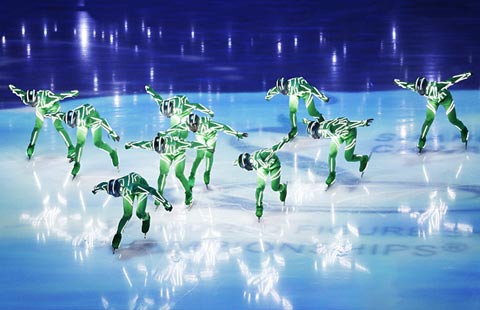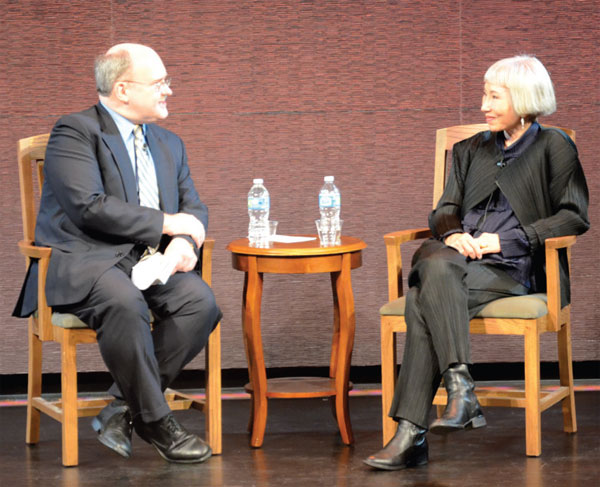Amy Tan talks about writing
Updated: 2015-03-26 11:29
By Niu Yue in New York(China Daily USA)
|
||||||||
|
Chinese-American writer Amy Tan discusses her thoughts as a writer with critic Ken Smith at the New York Historical Society on Tuesday. [Lu Huiquan / For China Daily] |
"If your photographs aren't good enough, you're not close enough," legendary photographer Robert Capa once said.
Apparently, the same rule applies when writing an international best-seller. Good writers have to go into a story before they can tell their own, according to celebrated Chinese-American novelist Amy Tan.
"It's the details that enable you to sensorially be there and emotionally be there," said Tan at the New York Historical Society on Tuesday. "If someone believes in you emotionally, that will cover a lot. You can practically say anything, and they will believe it."
Where do all those details come from?
Research, Tan said. "Certainly, the Internet has changed research, but I still do the go-to-the-source kind of research. I think writing a novel is an excuse to do research," she said. "Research is one of the best parts of the writing."
Tan was born in 1952 in Oakland, California, to Chinese immigrants. She had never been to China until 1987, when she went to fulfill her mother's wish to seek out and find lost family members.
The experience provided her with a new perspective on her tense relationship with her mother and became the inspiration for her breakout best-seller The Joy Luck Club. Published in 1989, it explored four interlocking mother-daughter relationships and the identity of Chinese-American women.
Tan has a strong love for visualization. She began to draw pictures even before starting to read at age 4.
In researching her 2013 book The Valley of Amazement, she went to museums, talked to scholars, investigated whether some of the people she was interested in used toilet paper or how much a newspaper cost.
Through her research she also learned there was a possibility that her grandmother was poisoned to death.
Her research is not "organized in any way at all, each one is linked to the other, to the other. These pieces would come along the way, and I will integrate them."
In preparing her 2008 opera The Bonesetter's Daughter, she went to Dimen, a remote village in southwestern China's Guizhou province, to live with an ethnic group with a singing language that has no written form.
"What's better research than that?" said Tan. "Even though not all of it was used in the opera, I used that scene, that scenery, that sensibility."
For a separate 5,000-word piece for National Geographic about the village and its distinctive culture at the risk of extinction, she revisited the village three times. The workload, said Ken Smith, the moderator of the event, was "quite intense".
"Every time I walked by, I was asked [by other villagers]: 'Have you eaten?'" said Tan.
She shared other anecdotes, including the conflicts she encountered when producing the film of The Joy Luck Club. She argued with the producers so that there would be no explicit sexual scenes in the movie.
The event was part of Chinese Americans: Exclusion/ Inclusion, an exhibition at the New York Historical Society.
Lu Huiquan and Hong Xiao in New York contributed to this story.

 Top 10 steel producers in China
Top 10 steel producers in China
 Highlights of China Fashion Week
Highlights of China Fashion Week Cockpit mystery emerges
Cockpit mystery emerges
 ISU figure skating worlds opens in Shanghai
ISU figure skating worlds opens in Shanghai
 Canola flowers form the emblem of harmony
Canola flowers form the emblem of harmony
 Your city in the shape of tiny round planet
Your city in the shape of tiny round planet
 Families mourn victims of Airbus A320 crash
Families mourn victims of Airbus A320 crash
 38,000 Brazilian troops to safeguard 2016 Rio Olympics
38,000 Brazilian troops to safeguard 2016 Rio Olympics
Most Viewed
Editor's Picks

|

|

|

|

|

|
Today's Top News
US invites Brazil's Rousseff for official visit
RMB hub makes a splash
US offers support to military action against Yemen's rebels
US sending Bill Clinton for Lee Kuan Yew's funeral
US military charges ex-Taliban captive Bergdahl
China, US work to clear legal hurdles
Cockpit voice recorder of crashed German plane found
US states reach out to China
US Weekly

|

|








